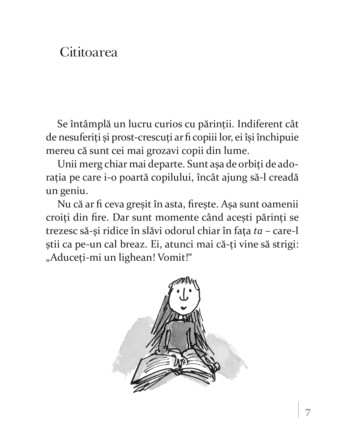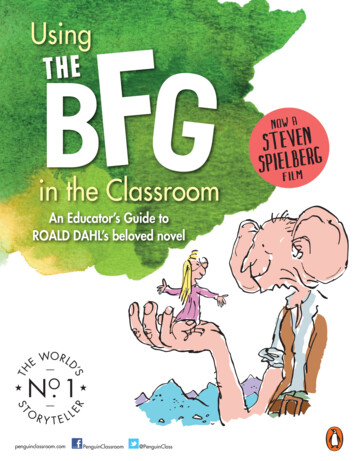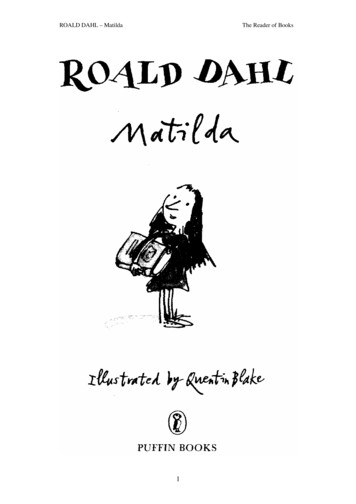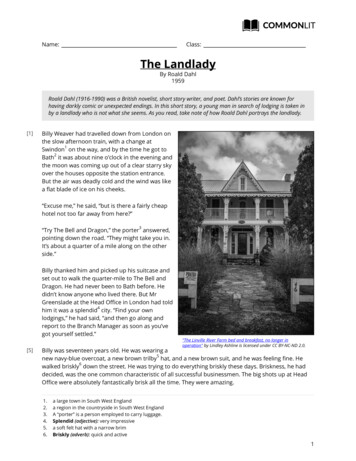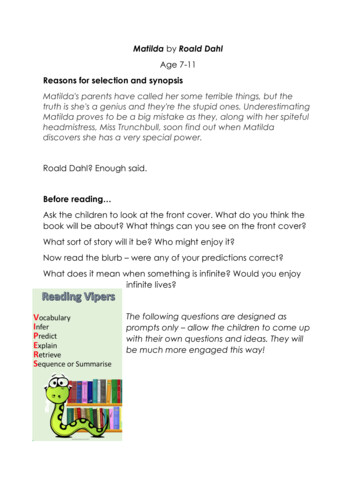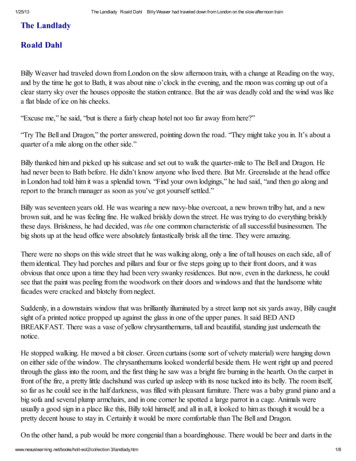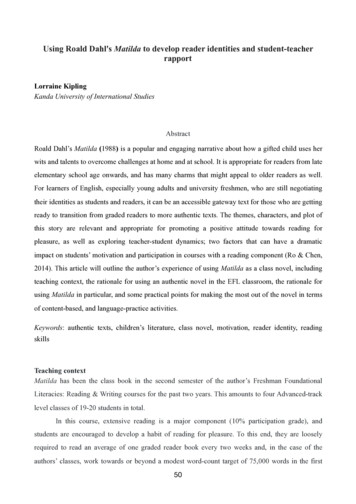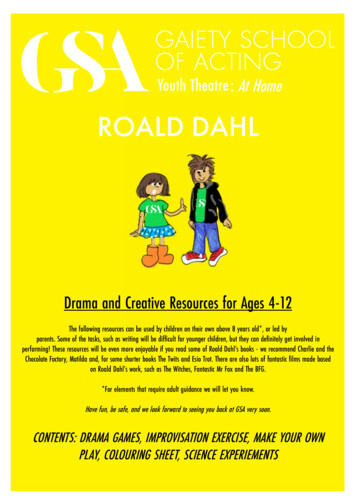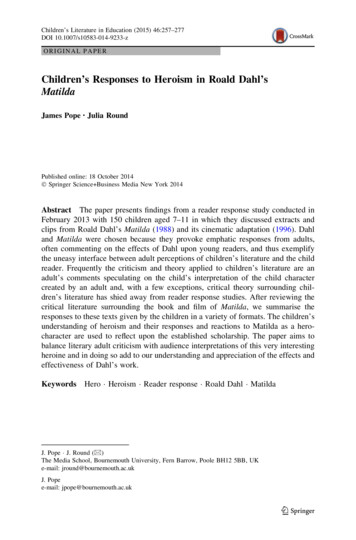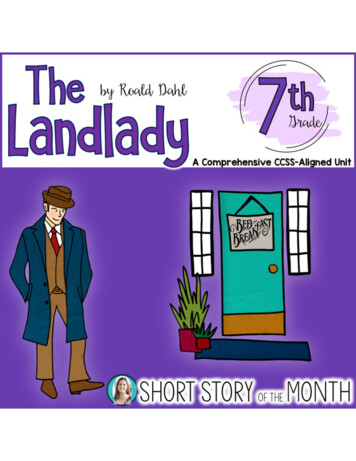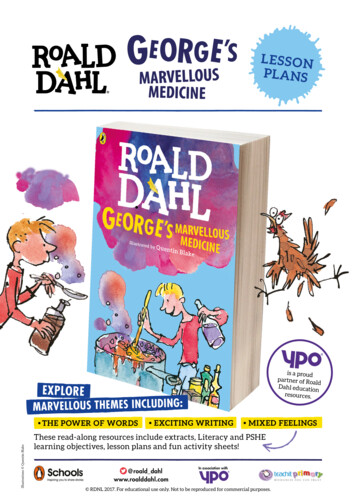
Transcription
LESSONPLANS is a proudpartner of RoaldDahl educationresources.EXPLOREMARVELLOUS THEMES INCLUDING:Illustrations Quentin Blake THE POWER OF WORDS EXCITING WRITING MIXED FEELINGSThese read-along resources include extracts, Literacy and PSHElearning objectives, lesson plans and fun activity sheets!@roald dahlwww.roalddahl.comIn association with RDNL 2017. For educational use only. Not to be reproduced for commercial purposes.
CONTENTSLESSON PLAN 1:LESSON PLAN 4:BOOK THEME: The power of wordsLITERACY OBJECTIVE: Identifyingalliteration, onomatopoeia and rhymingpatterns in Roald Dahl’s poetry and exploringtheir effect on the reader. Writing an originalpoem, using Roald Dahl’s work as a model.PSHE OBJECTIVE: Participatingconstructively in discussions by makingappropriate comments, taking turns andlistening to others.EXTRACT USED: from ‘The Cook up’ .BOOK THEME: RevengeneLITERACY OBJECTIVE: Drawing inferencesand justifying them with evidence from the text.Demonstrating a deep understanding of thecharacter of Grandma and creating an originalcharacter profile based upon George’s Grandma.PSHE OBJECTIVE: Understanding thatrevenge has a negative impact on both theperpetrator and the victim.EXTRACT USED: from ‘Grandma’LESSON PLAN 5:LESSON PLAN 2:BOOK THEME: Masters of InventionLITERACY OBJECTIVE:Using alliteration and adverbs effectively.Using persuasive language.PSHE OBJECTIVE: Understanding thatcommonly available substances and drugscan damage health.EXTRACT USED: from ‘George Beginsto Make the Medicine ‘.BOOK THEME: Sensational storiesLITERACY OBJECTIVE: Identifying and usingexciting verbs, adverbs and adjectives. Planning apiece of writing based upon the vocabulary andstructure of George’s Marvellous Medicine.PSHE OBJECTIVE: Providing, receiving andresponding to constructive feedback, recognisingand learning from others’ experience.EXTRACT USED: from ‘Grandma’.LESSON PLAN 6:LESSON PLAN 3:BOOK THEME: Exciting writingLITERACY OBJECTIVE: Identifying howRoald Dahl uses language, punctuation andtext styles to generate excitement. Writingsimiles using Roald Dahl’s work as a stimulus.Understanding how dramatic techniques bringstories to life.EXTRACT USED: from ‘Grandma Getsthe Medicine’.BOOK THEME: Mixed feelingsLITERACY OBJECTIVE: Drawing inferencesabout characters’ feelings, justifying theirinferences with evidence from the story.PSHE OBJECTIVE: Understanding what ismeant by having conflicting (or ‘mixed’) emotionsIdentifying when to heed emotions and when totry to overcome them.EXTRACT USED: from ‘Grandma’.Illustrations Quentin Blake GEORGE’S MARVELLOUS MEDICINE POSTER ACTIVITY SHEETS X 3 INVENTOR’S LOG THINGS YOU MAY NEED FOR THESELESSON PLANS@roald dahlwww.roalddahl.comIn association with2
LESSON PLAN 1BOOK THEMES: The power of wordsLESSON OBJECTIVES: Identifying alliteration, onomatopoeia and rhyming patterns inRoald Dahl’s poetry and exploring their effect on the reader Writing an original poem, using Roald Dahl’s work as a model Participating constructively in discussions by making appropriatecomments, taking turns and listening to othersTHINGS YOU MAY NEED FOR THIS LESSON:Poetry writing resources and rhyme games. See page 47PREPARATION:Each child will need a copy of both extracts and of each of the three resources. For activity two,you will need to provide each child with a copy of a common tongue twister and each group witha saucepan, a wooden spoon and a selection of revolting ingredients - a smelly sock, a rubbersnake, a jar of slime (there are plenty of recipes available on the internet), etc.STARTER ACTIVITY:Read extract one. Ask children what George is putting into his medicine. Which adjectives hasRoald Dahl used to describe some of the ingredients? What effect do these adjectives have on us asreaders?MAIN TASK: WONDROUS WORDSDivide children into groups. Set up a carousel of activities in which children investigate howRoald Dahl skilfully manipulates words to achieve extraordinary effects.Activity one: Children read extract one independently, then invite one or two to read it aloud.Which words rhyme? Is there any rhyming pattern to the poem? Prompt them to notice that it’swritten in rhyming couplets. Why do children think Dahl used rhyming couplets? What effectdoes this have on the reader? Children should use RESOURCE1: REVOLTING RHYMES to generatenew rhyming words for Roald Dahl’s poem.Illustrations Quentin BlakeContinued . . .@roald dahlwww.roalddahl.comIn association with3
LESSON PLAN 1Activity two: Give children copies of extract one along with some well-known tongue twisterslike ‘She sells sea shells on the sea shore’, ‘Red lorry, yellow lorry, red lorry, yellow lorry’ and ‘PeterPiper picked a peck of pickled pepper’. Why are these called tongue-twisters? How does the extractcompare with the tongue-twisters? Clarify that when words close together start with the sameletter or sound it’s called ‘alliteration’. Why do children think that Roald Dahl used alliteration?Set out a revolting selection of ingredients – a smelly sock, a rubber snake, pretend worms, a trayof mud, a jar of slime, a revolting picture of a slug, something hairy and so on – together with asaucepan and a spoon. Each child chooses something to drop into the saucepan. As they stir theysay the name of their ingredient together with an alliterative adjective: ‘mouldy mud’. Extend byasking them for two alliterative adjectives, for example: ‘slippery, sludgy slime’.Activity three: Introduce the term ‘onomatopoeia’ if children don’t know it. Ask children to definethe word ‘onomatopoeia’. Why do they think Roald Dahl has used onomatopoeia in his poem? Askchildren to highlight all the noisy (onomatopoeic) words in extract one, then to write down as manynoisy words as they can think of to match the pictures on RESOURCE 2: SOUND SCORCERY.DEVELOPING THE ACTIVITY: PERILOUS POTIONSRead extract two, William Shakespeare’s ‘Double, double toil and trouble’ from Macbeth. Examinethe poem together so that children understand the context if they are unfamiliar with the play.Discuss which ingredients the witches have thrown into their cauldron, deciphering trickylanguage. Children should compare and contrast this poem to Roald Dahl’s. In order to do this,divide them into small groups and give each group a copy of extracts one and two. Ask each group tocompare a different literary feature: alliteration, onomatopoeia, rhyming pattern, use of repetitionand the subject matter itself. After a few minutes ask children to feed back their discoveries to theclass. Do they think that Roald Dahl was influenced by William Shakespeare? Why or why not?Invite children to write their own magic medicine poem on RESOURCE 3: MY PERILOUSPOTION; they should use what they’ve written on resources one and two to help them.EXTENSION:You may also like to introduce a DT/ Computing element, asking children to design covers for a class‘magic medicine’ recipe book. Start by analysing the features of ordinary cookbook covers. Discusswhat will be the same and what will need to be adapted given that theirs is an enchanted recipe book.Illustrations Quentin BlakePLENARY:Divide children into small groups and ask them to choose one poem from the group toperform. Give them time to practise performing their own poems, perhaps playing aYouTube dramatization of ‘Double, double toil and trouble’ as inspiration.Children take turns to perform their poems. After each performance ask the audience tocomment positively upon what they have seen, encouraging them to talk about what theyenjoyed using terms such as ‘alliteration’, ‘onomatopoeia’, ‘rhyme’, ‘repetition’ and ‘adjectives’,as well as ways in which the actors engaged with the audience, bringing the poem to life.@roald dahlwww.roalddahl.comIn association with4
EXTRACT FROMEXTRACT ONEfrom ‘The Cook-up’ (p.34)Illustrations Quentin Blake‘Fiery broth and witch’s brewFoamy froth and riches blueFume and spume and spoondrift sprayFizzle swizzle shout hoorayWatch it sloshing, swashing, sploshingHear it hissing, squishing, spissingGrandma better start to pray.’@roald dahlwww.roalddahl.comIn association with5
EXTRACT FROMEXTRACT TWODouble, double toil and trouble, Macbeth, William ShakespeareDouble, double toil and trouble;Fire burn and caldron bubble.Fillet of a fenny snake,In the caldron boil and bake;Eye of newt and toe of frog,Wool of bat and tongue of dog,Adder’s fork and blind-worm’s sting,Lizard’s leg and howlet’s wing,For a charm of powerful trouble,Like a hell-broth boil and bubble.Illustrations Quentin BlakeDouble, double toil and trouble;Fire burn and caldron bubble.Cool it with a baboon’s blood,Then the charm is firm and good.@roald dahlwww.roalddahl.comIn association with6
REVOLTINGRHYMESRoald Dahl was the ruler of rhyme. Has he met his match in you today? Here’s yourchallenge: follow the smoky lines and rhyme the words below. If you can think of evenmore rhymes, then take a bow and accept your crown as the new king or queen!FEARSEEWORMGOESSMELLIllustrations Quentin BlakeSTRONGSMOKEKNEW@roald dahlwww.roalddahl.comIn association with7
SOUNDSCORCERYIllustrations Quentin BlakeGeorge’s bubbling brew pops, fizzes and crackles as it boils. How goodare you at generating loud language (also known as onomatopoeia.Try saying it: on-oh-mat-oh-pea-yah)? Let’s see what you can do!@roald dahlwww.roalddahl.comIn association with8
MY PERILOUSPOTIONSaucepans at the ready, it’s time to make your own magic medicine. First you need to decidewhat special power your magic medicine will have. Then you need a revolting recipe.for’s perilous potionpotion’s special powersREVOLTING RECIPE:INGREDIENTS:A generous helping ofrhyming coupletsFor example: ‘Throwin a wiggly, squigglyworm. That should makeyour tummy squirm’.Resource 1 should give youplenty of ideas if you arestuck. You can do it!A sprinkling ofonomatopoeia‘Pop’, ‘bang’, ‘sizzle’, ‘whizz’. See Resource 2– there’s plenty there.A dash of alliteration‘Now a slimy, slithering,slug ’Illustrations Quentin BlakeA splash of repetition asrequired. Shakespearerepeated the line ‘Double,double toil and trouble’.What could you writeinstead? ‘Hubble, stubble,saucepan bubble’? Youcan be as silly as you like!@roald dahlwww.roalddahl.comIn association with9
LESSON PLAN 2BOOK THEMES: Masters of InventionLESSON OBJECTIVES: Using alliteration and adverbs effectively Using persuasive language Understanding that commonly availablesubstances and drugs can damage healthTHINGS YOU MAY NEED FOR THIS LESSON:Whiteboards, SPAG pop up and camcorder.See page 47PREPARATION:Photocopy extract two for each child and a copy each of RESOURCE 1: INCREDIBLEINGREDIENTS. You will also need a selection of household products so that the classroomcan divided into four of George’s rooms: bathroom, bedroom, laundry room and kitchen. Fortask three, cut up and photocopy RESOURCE 3: WORDS TO PERSUADE so that each group ofchildren has a bank of words on their table in a saucepan.STARTER ACTIVITY: AMAZING ADJECTIVES AND ARTFUL ALLITERATION1. Read extract one. Ask children what they think Roald Dahl is trying to teach us about medicines.How is his message relevant to the story? Are children allowed to help themselves to medicinesat home? Why not? Ensure they understand that medicines are only safe if taken responsibly andunder adult supervision. Briefly discuss the importance of following correct dosage instructions,never taking out-of-date medicine and medicine which has been prescribed for somebody else.Illustrations Quentin Blake2. Ask children to help you list some of the bathroom products that George used in his magicmedicine. As they name products, list them in their simplest form e.g. ‘shampoo’, ‘face cream’,‘shaving foam’. Ask children to choose one item from the list and to add a proper noun and anadjective to the front e.g. ‘Sharon’s shocking shampoo’. Make sure that children understand thefunctions of proper nouns and adjectives as well as the correct use of apostrophes. Children arelikely to use alliteration naturally at least some of the time; when they do, elicit the effect that ithas on the reader i.e. it adds humour and a pleasing sense of rhythm.3. Children read extract two. Which room is George in? Which products is he pouring into hismedicine? Using RESOURCE 1: INCREDIBLE INGREDIENTS, children practise generating propernouns and adjectives to inject Roald Dahl humour into everyday products. Extra points givenfor alliteration!@roald dahlwww.roalddahl.comIn association with10
LESSON PLAN 2MAIN ACTIVITY:Divide your classroom tables into four groups so that there’s one large table for each of the fourrooms that George enters: bathroom, bedroom, laundry room, and kitchen. On each table placeproducts that are appropriate to that room. Children need to be able to identify the products butnot to read their brand names - you could wrap items or stick blank labels over them. DisplayRESOURCE 2: ABSOLUTELY AWFUL ADVERBS. What do children notice about these words?Every word ends in ‘ly’! Clarify that these are adverbs, and that one job of adverbs is to add moreinformation to adjectives. Using resource two as a prompt, explain that children should choose anitem from the table, write it on their whiteboard and then to add a proper noun, an adverb and anadjective to the front of the name e.g. ‘Sharon’s shockingly shimmering shampoo’. Challenge themto use alliteration if they can. Children move around the ‘rooms’ adding to their whiteboards asthey go. At the end, ask children to keep just three of their favourite ideas and rub off the rest.They will need these ideas next!DEVELOPING THE ACTIVITY: THE POWER OF PERSUASIONDisplay extract one. Read out: ‘NEVERMORE PONKING DEODORANT SPRAY, GUARANTEED TO KEEP AWAY UNPLEASANT BODY SMELLS FOR A WHOLE DAY’. Highlight the slogan‘guaranteed to keep away unpleasant body smells for a whole day’. Tell children that this is calleda slogan and ask them to deduce the purpose of advertising slogans, eliciting that they are apersuasive device with the aim of making money; clever slogans make you believe that your lifewill be better if you buy that product. Give children copies of extract two and, in pairs, ask them toidentify slogans within the text. Divide the children into four or five groups. On each group’s tableplace a saucepan containing words that you’ve cut from RESOURCE 3: WORDS TO PERSUADE.Using their ideas from the previous activity, children visit a table, take a word from the saucepan,and use that word to make up and record a slogan for each of the products on their whiteboard.Before children begin, model the activity e.g. ‘Sharon’s shockingly shimmering shampoo, forradiant hair with an unbeatable shine’. Children record their ideas on paper.EXTENSION ACTIVITIES:Children might like to storyboard, perform and record a television advertisement for one of theproducts that they’ve created. Alternatively, they could design and make packaging for their product.Illustrations Quentin BlakePLENARY:Ask children to choose one of the slogans they have recorded today and to try to persuadeanother child to buy their product. The child who is the ‘customer’ should challenge theseller’s claims using the question words ‘how?’, ‘what?’, ‘why?’ e.g. ‘How will it make me morefashionable?’, ‘What is in this product that makes it healthy?’, ‘Why is your product betterthan another one on the market?’ The customer should then decide whether they would buythe product based upon the seller’s persuasive language!@roald dahlwww.roalddahl.comIn association with11
EXTRACT FROMEXTRACT ONEfrom ‘George Begins to Make the Medicine’ (pp. 17-21)Illustrations Quentin Blake“In the bathroom, he gazed longingly at the famous and dreaded medicine cupboard.But he didn’t go near it. It was the only thing in the entire house he was forbidden totouch. He had made solemn promises to his parents about this and he wasn’t going tobreak them. There were things in there, they had told him, that could actually kill aperson, and although he was out to give Grandma a pretty fiery mouthful, he didn’t reallywant a dead body on his hands. George put the saucepan on the floor and went to work.Number one was a bottle labelled GOLDEN GLOSS HAIR SHAMPOO. He emptiedit into the pan. ‘That ought to wash her tummy nice and clean,’ he said.He took a full tube of TOOTHPASTE and squeezed out the whole lot of it in one longworm. ‘Maybe that will brighten up those horrid brown teeth of hers,’ he said.There was an aerosol can of SUPERFOAM SHAVING SOAP belonging to his father.George loved playing with aerosols. He pressed the button and kept his finger on ituntil there was nothing left. A wonderful mountain of white foam built up in the giantsaucepan.With his fingers, he scooped out the contents of a jar of VITAMIN ENRICHED FACECREAM.In went a small bottle of scarlet NAIL VARNISH. ‘If the toothpaste doesn’t clean herteeth,’ George said, ‘then this will paint them as red as roses.’He found another jar of creamy stuff labelled HAIR REMOVER. SMEAR IT ONYOUR LEGS, it said, AND ALLOW TO REMAIN FOR FIVE MINUTES. Georgetipped it all into the saucepan.There was a bottle with yellow stuff inside it called DISHWORTH’S FAMOUSDANDRUFF CURE. In it went.There was something called BRILLIDENT FOR CLEANING FALSE TEETH. It wasa white powder. In that went, too.He found another aerosol can, NEVERMORE PONKING DEODORANT SPRAY,GUARANTEED, it said, TO KEEP AWAY UNPLEASANT BODY SMELLS FORA WHOLE DAY. ‘She could use plenty of that,’ George said as he sprayed the entirecanful into the saucepan. “@roald dahlwww.roalddahl.comIn association with12
EXTRACT FROMEXTRACT TWOfrom ‘George Begins to Make the Medicine’ (pp. 21-24)Illustrations Quentin Blake“On his mother’s dressing-table in the bedroom, George found yet another lovelyaerosol can. It was called HELGA’S HAIRSET. HOLD TWELVE INCHES AWAYFORM THE HAIR AND SPRAY LIGHTLY. He squirted the whole lot into thesaucepan. He did enjoy squirting these aerosols.There was a bottle of perfume called FLOWERS OF TURNIPS. It smelled of oldcheese. In it went.And in, too, went a large round box of POWDER. It was called PINK PLASTER.There was a powder-puff on top and he threw that in as well for luck.He found a couple of LIPSTICKS. He pulled the greasy red things out of their littlecases and added them to the mixture.The bedroom had nothing more to offer, so George carried the enormous saucepandownstairs again and trotted into the laundry-room where the shelves were full of allkinds of house-hold items.The first one he took down was a large box of SUPERWHITE FOR AUTOMATICWASHING-MACHINES. DIRT, it said, WILL DISAPPEAR LIKE MAGIC. Georgedidn’t know whether Grandma was automatic or not, but she was certainly a dirty oldwoman. ‘So she’d better have it all,’ he said, tipping in the whole boxful.Then there was a big tin of WAXWELL FLOOR POLISH. IT REMOVES FILTHAND FOUL MESSES FROM YOUR FLOOR AND LEAVES EVERYTHING SHINYBRIGHT, it said. George scooped the orange-coloured waxy stuff out of the tin andplonked it into the pan.There was a round cardboard carton labelled FLEA POWDER FOR DOGS. KEEPWELL AWAY FROM THE DOG’S FOOD, it said, BECAUSE THIS POWDER, IFEATEN, WILL MAKE THE DOG EXPLODE. ‘Good,’ said George, pouring it all intothe saucepan.”@roald dahlwww.roalddahl.comIn association with13
INCREDIBLEINGREDIENTSFill George’s saucepan with as many incredible ingredients as you can imagine. Describeeach ingredient with a perfect proper noun and an atrocious adjective. If you can usealliteration then even better for producing a perfectly potent potion!EXAMPLE: Hilda’s horrible hairsprayperfumepowderlipstickwashing powderIllustrations Quentin Blakefloor polishflea powder@roald dahlwww.roalddahl.comIn association with14
Illustrations Quentin BlakeABSOLUTELYAWFUL oald dahlwww.roalddahl.comIn association with15
Illustrations Quentin azingWONDERFULLYOUTSTANDINGLYeffectively@roald dahlwww.roalddahl.comIn association with16
LESSON PLAN 3BOOK THEMES: Exciting writingLESSON OBJECTIVES: Identifying how Roald Dahl uses language, punctuation and textstyles to generate excitement Writing similes using Roald Dahl’s work as a stimulus Understanding how dramatic techniques bring stories to lifeTHINGS YOU MAY NEED FOR THIS LESSON:Spelling board games, copier paper and handwriting pens. See page 47PREPARATION:Each child will need a copy of the extract and each of the three resources. You will also need tocollect props and equipment for children’s dramatic performances of George’s Marvellous Medicine.STARTER ACTIVITY: SASSY SIMILIESWhat is a simile? Clarify that a simile compares two things using the words ‘as’ or ‘like’. Give someexamples e.g. ‘he was as brave as a lion’, ‘she was as white as a ghost’, ‘he slept like a log’. Can childrenthink of any themselves? Read the extract together. Can children spot the simile? (‘Up she wentlike a jack-in-a-box’.) Why do they think Dahl used this simile? What effect does it have? UsingRESOURCE 1: SASSY SIMILES, children should think of original similes to describe Grandma.MAIN ACTIVITY: EXCITING WRITINGRead the extract together. Display the question: ‘How does Roald Dahl build excitement in hiswriting?’ Share ideas, ensuring children have made note of Roald Dahl’s use of punctuation,italics and onomatopoeia. As well as drawing their attention to the use of ellipses, exclamationmarks and onomatopoeia, elicit that shorter sentences create a ‘heart-beat’ effect which generatesexcitement. Look at the differences between the verbs used for Grandma and George: George saidbut Grandma yelled. Help children to see that George’s behaviour is calm which makes Grandma’spanic even more pronounced. List the techniques you have discussed on the board and askchildren to work in pairs to find and identify examples in the extract. They then write their ownexciting passage using RESOURCE 2: EXCITING WRITING.Illustrations Quentin BlakeContinued . . .@roald dahlwww.roalddahl.comIn association with17
LESSON PLAN 3DEVELOPING THE ACTIVITY: STICKY SITUATIONSRead the extract to the children in a boring monotone voice. What do they think of yourreading? What effect does it have on the listener? Now show a clip of a reading of oneof Dahl’s stories (Rik Mayall’s reading of George’s Marvellous Medicine is an excellentexample and is available on YouTube). Ask for children’s opinions about the performance.How was it different to your performance? Which techniques have been used to bring thestory to life? (Consider facial expressions, funny voices, props, costume and sound effects.)Invite children to choose an exciting extract, about three or four pages long, from George’sMarvellous Medicine. They should plan a reading using RESOURCE 3: POWERFULPERFORMANCES to guide them, and then practise their performance.Illustrations Quentin BlakePLENARY:Divide the class into groups, so that each child has a chance to performtheir dramatic reading of George’s Marvellous Medicine before a smallaudience. Many children will be more comfortable reading in front ofa few people rather than a larger group which, in turn, will enhancetheir performance. Once all the children have had a turn, ask theclass to discuss in pairs the elements that they believe contribute to asuccessful performance of George’s Marvellous Medicine.@roald dahlwww.roalddahl.comIn association with18
EXTRACT FROMEXTRACT ONEfrom ‘Grandma Gets the Medicine’ (pp. 38-41)Illustrations Quentin Blake‘Are you going to gulp it all down in one go?’ George asked her. ‘Or will you sip it?’‘What I do is none of your business,’ the old woman said. ‘Fill the spoon.’As George removed the cork and began very slowly to pour the thick brown stuff intothe spoon, he couldn’t help thinking back upon all the mad and marvellous things thathad gone into the making of this crazy stuff – the shaving soap, the hair remover, thedandruff cure, the automatic washing-machine powder, the flea powder for the dogs,the shoe-polish, the black pepper, the horseradish sauce and all the rest of them, not tomention the powerful animal pills and powders and liquids and the brown paint.‘Open your mouth wide, Grandma,’ he said, ‘and I’ll pop it in.’The old hag opened her small wrinkled mouth, showing disgusting pale brown teeth.‘Here we go!’ George cried out. ‘Swallow it down!’ He pushed the spoon well into hermouth and tipped the mixture down her throat. Then he stepped back to watch the result.It was worth watching.Grandma yelled ‘Oweeeee!’ and her whole body shot up whoosh into the air. It wasexactly as though someone had pushed an electric wire through the underneath of herchair and switched on the current. Up she went like a jack-in-the-box and she didn’tcome down she stayed there suspended in mid-air about two feet up still ina sitting position but rigid now frozen quivering the eyes bulging the hairstanding straight up on end.‘Is something wrong, Grandma?’ George asked her politely. ‘Are you all right?’Suspended up there in space, the old girl was beyond speaking.The shock that George’s marvellous mixture had given her must have beentremendous.You’d have thought she’d swallowed a red-hot poker the way she took off from thatchair.Then down she came again with a plop, back into her seat.‘Call the fire brigade!’ she shouted suddenly. ‘My stomach’s on fire!’‘It’s just the medicine, Grandma,’ George said. ‘It’s good strong stuff.’‘Fire!’ the old woman yelled. ‘Fire in the basement! Get a bucket! Man the hoses! Dosomething quick!’‘Cool it, Grandma,’ George said. But he got a bit of a shock when he saw the smokecoming out of her mouth and out of her nostrils. Clouds of black smoke were comingout of her nose and blowing around the room.‘By golly, you really are on fire,’ George said.‘Of course I’m on fire!’ she yelled. ‘I’ll be burned to a crisp! I’ll be fried to a frizzle!I’ll be boiled like a beetroot!’@roald dahlwww.roalddahl.comIn association with19
SASSYSIMILESSimiles create imagery; this means that they paint instantpictures in our heads. Roald Dahl was very good at usingsimiles to make funny, pop-up pictures: ‘Up she went like ajack-in-the-box’ and ‘she shot out of the roof like a rocket!’Can you finish the similes below?Grandma’s stomach exploded likeGrandma was as shocked asIllustrations Quentin BlakeIt’s time to think of your own silly similes for Grandma. Remember to use the words‘as’ or ‘like’ in your sentences. You could think about Grandma’s personality traits or herappearance e.g. ‘Grandma was as bitter as/as spiteful as ’, ‘Her teeth were brown like ’Now off you go - invent as ingeniously as George himself!@roald dahlwww.roalddahl.comIn association with20
EXCITINGWRITING!Can you deliver a dose of skin-tingling excitement to the idea below?To make your writing exciting, remember to bring it alive by adding some: DIRECT SPEECH. “‘Fire!’ the old woman yelled,” (rather than “the old woman was on fire”) EXCITING PUNCTUATION like ellipses or exclamation marks (but not too many asthis reduces their power – a bit like having Christmas every day) ONOMATOPOEIA FAST-PACED, EXCITING ACTION mixed in with some calmer bits. The calm makesthe storm seem all the stronger.THE IDEA:There is a problem in the playground at George’s school. Billy the Bully has beenpunching some of the younger children and taking food from their lunchboxes.George has discovered that there’s some of Grandma’s Marvellous Medicine stillleft in the cupboard. He decides to give it to Billy the Bully. The effect that themedicine has on Billy is surprisingly different to the effect that it had on Grandma.Illustrations Quentin BlakeChapter 7: Billy the Bully Gets the Medicine@roald dahlwww.roalddahl.comIn association with21
POWERFULPERFORMANCESpresents George’s Marvellous Medicine!My costume is:This is the setting:(the room in George’s house)My chosen extract is: PageHere are my props:to PageOther techniques I will use:Illustrations Quentin Blakeuse (consider where you might use a funnyvoice or a different expression, for example):@roald dahlwww.roalddahl.comIn association with22
LESSON PLAN 4BOOK THEMES: RevengeLESSON OBJECTIVES: Drawing inferences and justifying them with evidencefrom the text Demonstrating a deep understanding of the characterGrandma and creating an original character profilebased upon George’s Grandma Understanding that revenge has a negative impact onboth the perpetrator and the victimTHINGS YOU MAY NEED FOR THIS LESSON:Exercise books and feelings and emotions cards.See page 47PREPARATION:Each child will need a copy of each resource. You will also need to make enough copies of extracttwo and extract three for half the class. Provide a selection of tourist information leaflets detailinglocal days out as well as transport time tables.STARTER ACTIVITY: GRUESOME GRANDMAIllustrations Quentin BlakeRead extract one together. What does this extract tell us about Grandma? List the followingadjectives on the board: selfish, lazy, cowardly. Ask children to pick one of these adjectives andto find evidence from the text to support this idea e.g. ‘Grandma is cowardly because she waitsuntil George’s parents have gone out before she mistreats him’. Children feed their ideas back to apartner before a sharing some as a class. Next divide the class in half. Give one half ex
task three, cut up and photocopy RESOURCE 3: WORDS TO PERSUADE so that each group of children has a bank of words on their table in a saucepan. STARTER ACTIVITY: AMAZING ADJECTIVES AND ARTFUL ALLITERATION 1. Read extract one. Ask children what they think Roald Dahl is trying to teach us a
